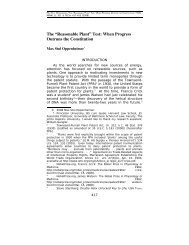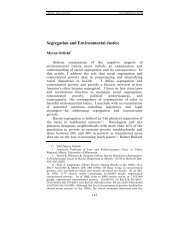An Organizational Approach to the Design of Patent Law
An Organizational Approach to the Design of Patent Law
An Organizational Approach to the Design of Patent Law
Create successful ePaper yourself
Turn your PDF publications into a flip-book with our unique Google optimized e-Paper software.
6 VERTINSKY FINAL_JAD (DO NOT DELETE) 2/27/2012 2:20 PM<br />
2012] AN ORGANIZATIONAL APPROACH 255<br />
In addition <strong>to</strong> increased funding, <strong>the</strong> USPTO implemented a pilot<br />
program for green technologies that is designed <strong>to</strong> expedite<br />
<strong>the</strong> processing <strong>of</strong> patent applications relating <strong>to</strong> clean energies.<br />
191 A simple incentive-based approach <strong>to</strong> patent law would<br />
suggest that increased funding <strong>of</strong> private sec<strong>to</strong>r R&D and faster<br />
processing <strong>of</strong> patents would <strong>to</strong>ge<strong>the</strong>r increase <strong>the</strong> speed and<br />
volume <strong>of</strong> development and deployment <strong>of</strong> green technologies.<br />
Applying <strong>the</strong> organizational approach, however, shifts <strong>the</strong><br />
starting point <strong>of</strong> analysis <strong>to</strong> alternative ways <strong>of</strong> organizing efforts<br />
<strong>to</strong> develop and deploy green technologies. 192 Transactions,<br />
such as <strong>the</strong> agreements between private parties in a patent<br />
pool or contracting arrangements between research entities<br />
and industry partners, are <strong>the</strong> units <strong>of</strong> analysis; <strong>the</strong> effects <strong>of</strong><br />
alternative patent laws on <strong>the</strong> cost and feasibility <strong>of</strong> different<br />
transactions are examined. Using this approach, <strong>the</strong> effectiveness<br />
<strong>of</strong> <strong>the</strong> USPTO program is evaluated in light <strong>of</strong> <strong>the</strong> most<br />
promising models <strong>of</strong> innovation, including attention <strong>to</strong> patent<br />
pools and patent commons. 193 When viewed from this perspective,<br />
increasing <strong>the</strong> speed and likelihood <strong>of</strong> patenting might<br />
hinder ra<strong>the</strong>r than enhance <strong>the</strong>se relationships. In addition,<br />
<strong>the</strong> ways in which public funding is provided and <strong>the</strong> ownership<br />
<strong>of</strong> publicly funded inventions need <strong>to</strong> be considered. Existing<br />
NIE work points <strong>to</strong> <strong>the</strong> importance <strong>of</strong> examining incentives<br />
<strong>of</strong> public and private ac<strong>to</strong>rs in light <strong>of</strong> default ownership<br />
ECON. COUNCIL, supra note 2 (identifying clean energies as one <strong>of</strong> <strong>the</strong> sec<strong>to</strong>rs<br />
identified for intervention).<br />
191. Green Technology Pilot Program, U.S. PAT. & TRADEMARK OFF.,<br />
http://www.usp<strong>to</strong>.gov/patents/init_events/green_tech.jsp (last modified Oct. 5,<br />
2011); see, e.g., EWING MARION KAUFFMAN FOUND., WHITE HOUSE ENERGY<br />
INNOVATION CONFERENCE: SUMMARY REPORT 10 (2010), available at<br />
http://www.energyinnovationnetwork.org/en/~/media/Files/WH_summary_rep<br />
ort.ashx (This report discusses <strong>the</strong> White House energy innovation agenda,<br />
which includes <strong>the</strong> USPTO pilot program <strong>to</strong> expedite processing <strong>of</strong> patent applications<br />
covering clean energy technologies under <strong>the</strong> assumption that<br />
“[p]roviding innova<strong>to</strong>rs with more timely patent protection will help bring<br />
technologies <strong>to</strong> market more quickly.”).<br />
192. See American Clean Energy and Security Act <strong>of</strong> 2009, H.R. 2454,<br />
111th Cong. (calling for $190 billion <strong>to</strong> develop clean energy technologies).<br />
193. See alternative models for sharing innovation such as <strong>the</strong> Eco-<strong>Patent</strong><br />
Commons established by IBM, Sony, Nokia, and Pitney Bowes. See Eco-<strong>Patent</strong><br />
Commons, WORLD BUS. COUNCIL FOR SUSTAINABLE DEV.,<br />
http://www.wbcsd.org/web/epc (last visited Aug. 16, 2010). Alternative models<br />
also can be found at <strong>the</strong> GreenXchange hosted by Creative Commons. See <strong>Patent</strong><br />
Licenses, SCI. COMMONS, http://sciencecommons.org/projects/patentlicenses<br />
(last visited Aug. 16, 2010).






